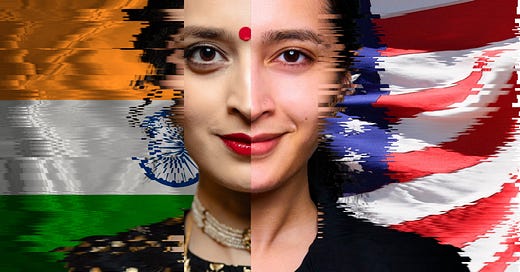Do you ever feel unmistakably Indian in the U.S., yet still disconnected from your Indian roots? Like you're caught between two cultures and not sure where you really belong?
You're not alone. I've felt that too. That feeling where you're too Indian for America and too American for India. But I discovered the path back to my roots wasn't through grand gestures or cultural performance. It was through something as simple as recreating my grandmother's chicken curry on a Tuesday night in San Francisco (which is where I lived when I first moved to the US).
The Slow Fade
When I first moved from Kolkata to the United States, I thought I could take a break from being Indian. I'd spent my entire life immersed in Bengali culture, why not explore something new? I avoided Indian restaurants, dismissed the festivals I'd grown up celebrating, and told myself this was just part of adjusting to my new life.
But culture doesn't disappear overnight. It erodes slowly, like water wearing away stone.
First, I started losing my fluency in Bengali. I still understand and speak it but it doesn’t flow as naturally as it used to due to the lack of regular practice. Then people began commenting on how my accent had changed, though I wasn't consciously trying to sound different. The festivals that once anchored my year became distant memories because they weren't national holidays here. Those small daily rituals from my childhood home, the sound of the conch shell every evening, the specific way we arranged our shoes by the door, the sounds of my grandmother's bangles as she cooked were replaced by the relentless pace of my life here in the US.
The real awakening came during visits home. In India, relatives would say I'd become "too American." Back in America, I was definitely Indian.
I started to wonder, what does Indian-American even mean in practice?
What It Doesn't Mean
Let me be clear about what embracing a bicultural identity isn't for me:
It's not wearing a bindi everywhere you go
It's not only drinking chai and rejecting all other beverages
It's not claiming butter chicken as your favorite dish to prove your authenticity
Even if you like all of these aspects of Indian culture like I do, the point I’m trying to make is that it’s much deeper than that.
More importantly, it's not about mathematical precision. You don't need to be exactly 50% American and 50% Indian, carefully measuring out your cultural expressions to achieve some perfect balance.
What It Actually Means
The revelation that changed everything for me was that I wasn't losing half of myself. I was doubling myself.
Instead of asking "Am I losing my identity?" or "Where do I belong?", I started asking: "How can I celebrate all parts of who I am? How can I create a sense of home within myself, no matter where I live?"
Being Indian-American isn't about splitting yourself in half. It's about being 100% American and 100% Indian simultaneously. It's having access to two incredibly rich, diverse cultures.
The Portal Home
While I might not be able to celebrate every festival with the same intensity as my childhood, while I might not speak Bengali as fluently as my parents, I could recreate the feeling of home through taste and smell.
Food became my portal.
The first time I made my family's chicken curry recipe in my American kitchen, something shifted. The smell of paanch phoron (Bengali five-spice) hitting hot oil transported me instantly back to my childhood kitchen in Kolkata. But this wasn't just nostalgia, it was active connection.
Making that curry wasn't just following instructions. It was:
Remembering my grandmother's hands guiding mine
Understanding the flavors that defined my upbringing
Connecting with the stories behind every ingredient
Exploring the incredible diversity within India itself
Creating a bridge between my past and present
More Than Just Recipes
Food carries our entire histories. When I cook for friends or clients here in the US, I'm not just serving a meal, I'm sharing pieces of my story and connections to a culture that spans thousands of years.
These cooking sessions became conversations about why we make specific dishes for Diwali, what the regional variations of different curries tell us about the people who created them, how techniques passed down through generations carry the wisdom of our ancestors.
Through food, I began exploring parts of my heritage I hadn't even fully known when I lived in India. I discovered dishes from regions I'd never visited, learned techniques from communities different from my own, understood the incredible complexity and diversity of what we simply call "Indian food."
The Real Revolution
The starting point for reconnecting with your roots doesn't have to be language or religion or festivals, though these are beautiful too. It can be something much more tangible and immediate: cooking.
That first successful chicken curry reminded me that culture isn't about doing everything "right" according to some external standard. It's about staying in touch with the parts of yourself that matter. It's about creating home wherever you are.
Food became my way of carrying my roots with me, no matter where I am in the world. It's how I stay connected to my heritage while fully embracing my American life. It's how I've learned to be whole instead of halved.
If you're tired of feeling like you're living between worlds instead of fully in both, if you're ready to embrace your unique identity and create a life that feels like home no matter where you are, I'd love to help you find your own portal home through food.
I help individuals reconnect with their roots through cooking, not just learning recipes, but understanding the stories, flavors, and techniques that make your cooking feel like home.
What dish from your childhood do you miss most? What smell can instantly transport you back home? I'd love to hear your story.




